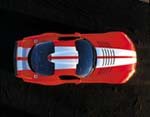THE DaimlerChrysler merger made sense in the automotive market initially. Here is
Daimler-Benz�Mercedes-Benz as far as the car line is concerned�a one-brand company. It is successful worldwide, but it occupies a distinct premium niche. Chrysler, with
its Dodge and recently retired Plymouth brands, could tackle the everyday to premium
markets, while Jeep gave Daimler-Benz a strong entrant in the still-fashionable SUV
stakes.
But as 2000 began, doubts are beginning to surface.
For a start, DaimlerChrysler does not have a obviously clear vision. To most observers, in identity,
investment and automotive strategy, it remains two companies with an umbrella name.
The new entity is clearly a different company from its individual units, with the capacity
to tackle the global markets in the same way as Volkswagen and Ford, both of which
went through merger-mania in the late 1990s. However, Ford has made active moves to
realign its company along brand lines both internally and externally.
Post-merger, DaimlerChrysler executives had to firstly decide on a lingua franca, and
English lessons were held in Germany. So already there's a transformation. The plants
now have the 'DaimlerChrysler' tag. But it seems the company has approached the
rebranding from the wrong angle: from my observations, it has tackled appearances first
without ever questioning what the new, merged corporation stands for. If it has, then I
haven't heard a whisper.
When an organization does not merge itself properly, the individual units begin
running out of steam. They have their separate past glories but the uncertainty eventually gets to the team. At this year's Detroit International Auto Show, DaimlerChrysler concepts were criticized for breaking no new ground.
The comments were justified. Many were stylish reinterpretations of existing Chrysler
products, such as the Dodge Maxxcab pickup�a futuristic Ram�and the Dodge Viper
GTS/R�a Viper for the millennium.
There's evidence that the SUV market is stalling, especially in fashionable California,
so offerings such as the Mercedes M-series and the Jeep line may experience a drop in
sales.
Of the new offerings, Chrysler and Dodge field new minivans to protect existing
market share. Mercedes-Benz's Smart brand will début new variants in 2000 and there
will also be a new C-class range. These are not really surprises but progressive developments of the existing range. Sales may be strong now, but I'm seeing question marks.
There are some welcome moves on the horizon: Chrysler's Java, which promises to be
better-built than the Neon (which in turn hasn't made much of a dent in Volkswagen Golf and
Ford Focus sales in Europe). But the company lacks a range which is directly focused at
the Golf and Focus: the Neon is only a sedan, while VW and Ford field ranges with
hatchbacks and wagons as well. With Europe moving to mini-minivans, a niche which
Nissan started in 1982 with its Prairie, DaimlerChrysler has the ultra-fashionable Chrysler PT Cruiser, which began life as a Plymouth concept. Yet it is gambling a great deal,
because there's no second car on that platform, such as a "B-class" Mercedes-Benz mini-minivan.
There is also the disappearance of the Plymouth brand. In years of late, Chrysler has
neglected Plymouth, using it as a price-leading brand for rebadged (I shouldn't even
say rebranded) Dodges such as the Plymouth Breeze and Voyager. The glories of the
Barracuda and the Fury were gone, and the only distinctive product was its limited-edition Prowler. However, Plymouth could have been to DaimlerChrysler what Skoda is
to Volkswagen. It would have taken years of brand-building, but DaimlerChrysler has
nothing to field in the budget or mass-market sector. Arguably, Smart, Dodge, Jeep, Chrysler and Mercedes-Benz occupy premium positions.
Solutions include purchasing another company. Fiat and PSA (Peugeot-Citroën) are
looking for partners, and teaming up with DaimlerChrysler would actually allow the
company to field some high-mileage cars to meet the 38 mpg average fleet fuel economy
in Europe by 2008. But DaimlerChrysler needs to ensure any prospective company that
it has properly integrated. Right now, Stuttgart still has work to do.
Now co-chairman Bob Eaton, credited with overseeing Chrysler's most prosperous and exciting period prior to the merger�and an all-round car guy�will retire on March 31. He has said the company's merger is complete and the structure is one. He knows something I don't.
 Jack Yan
Jack Yan
About Table 1 (below)
As our table shows, DaimlerChrysler doesn't have a proper mass-market brand. It will
attempt to extend Chrysler downwards into Europe�unfamiliar territory to the German
management, which has been used to Mercedes-Benz's global push. Consequently,
Chrysler will have a different perception on either side of the Atlantic, which is perhaps a
less than desirable result given that other companies are attempting global marketing
strategies for their lines. Already, the Chrysler badge adorns the entry-level Neon in
Europe, while it is clearly a Buick and Cadillac rival in the United States.
Dodge could be extended in Europe but for the Dodge trademark being owned by
Renault in Europe.
Other remarks about the table include the fact that Mazda remains ill-defined but
Ford needs a slightly sporty brand, which Mazda could become. The fact Mazda
management has green-lighted the development of the RX-Evolv says as much. Volkswagen is neatly spread and even its luxury V12 challenger will be positioned as a cheaper
rival to Mercedes-Benz and Jaguar. Despite criticisms about Dr Piech growing the company too much, Volkswagen seems to have occupied every market brand-wise. BMW's
troubles stem from lacking a mass-market brand although recent price adjustments to
the 25 and 45 see it entering this segment in 2000. GM's segments look fine on paper but
it masks the troubles it has had in managing companies such as Saab.
 Dodge Viper GTS/R Looks like a standard Dodge Viper with a body kit
Dodge Viper GTS/R Looks like a standard Dodge Viper with a body kit

